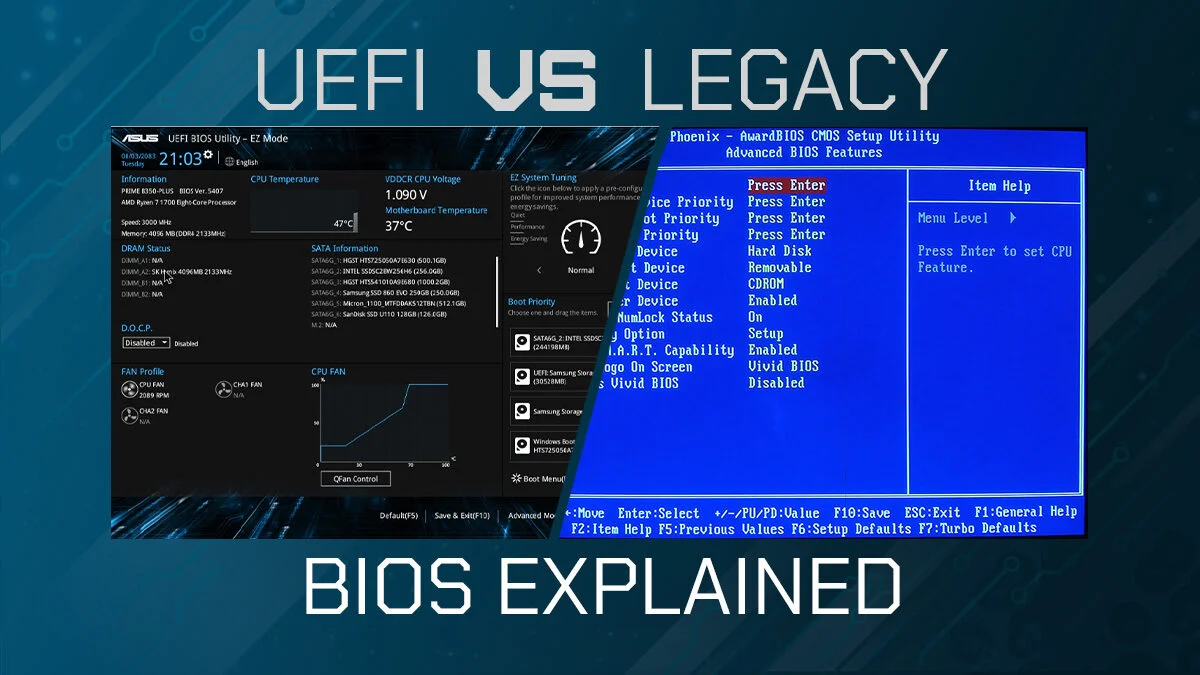UEFI, or Unified Extensible Firmware Interface, is the modern replacement for BIOS. It improves security, boot speed, and hardware compatibility on most newer systems. This guide explains what UEFI is, how it works, and how to manage UEFI settings for better control over your PC.
🧠 What Is UEFI?
UEFI is the standard firmware interface on most modern computers. It replaced the legacy BIOS system and offers key advantages:
- ⚡ Faster startup times
- 🔒 Secure Boot protection against malware
- 💽 Support for large drives (2TB+ via GPT)
- 🖱️ A graphical interface with mouse support
- 🧰 Advanced diagnostics and system control
🆚 UEFI vs BIOS: What’s the Difference?

BIOS (Legacy)
- Uses MBR partitioning
- Limited to 2TB drives
- Text-only interface, keyboard only
- 16-bit code limits advanced features
UEFI (Modern)
- Uses GPT partitioning
- Supports disks larger than 2TB
- GUI with mouse and keyboard
- 32- or 64-bit code supports richer features
🔍 How to Check if Your System Uses UEFI or BIOS
Option 1 – System Information
- Press
Win + R, typemsinfo32, and press Enter. - Find BIOS Mode:
- If it says UEFI, you’re using UEFI.
- If it says Legacy, your system uses BIOS.
Option 2 – Command Prompt
- Open Command Prompt (Admin)
- Type:
bcdedit /enum- If you see
\EFI\Microsoft\Boot\bootmgfw.efi, it’s UEFI.
🧭 UEFI Boot Process (Simplified)
- UEFI firmware powers on the hardware
- The UEFI boot process begins when the firmware powers on your system hardware. It then reads boot information from the EFI System Partition (ESP)
- Loads the Boot Manager (e.g., Windows Boot Manager or GRUB)
- Bootloader starts the operating system
🔒 What Is Secure Boot?
Secure Boot is a UEFI feature that blocks unsigned or untrusted boot software.
To check Secure Boot status:
- Run
msinfo32and look for Secure Boot State:- On = enabled
- Off = disabled
To enable Secure Boot:
- Restart and enter UEFI settings (usually
F2,DEL,ESC, orF12) - Find the Secure Boot section
- Enable it and save changes
🔑 How to Access UEFI Firmware Settings
- Go to Settings > Update & Security > Recovery
- Under Advanced startup, click Restart now
- Navigate to Troubleshoot > Advanced options > UEFI Firmware Settings
- Click Restart to enter the UEFI menu
You can also press your motherboard’s key during boot (usually F2, DEL, ESC, or F12).
💾 What Is the EFI System Partition (ESP)?
The ESP is a special partition where UEFI stores boot files.
To check for ESP:
- Open Command Prompt (Admin)
- Run these commands:
diskpart
list disk
select disk 0
list partitionCode language: PHP (php)Look for EFI System Partition in the list.
🔄 How to Convert MBR to GPT for UEFI Boot Compatibility
Without data loss (Windows 10 or newer):
mbr2gpt /convert /allowFullOSThen restart your PC.
With data loss (manual conversion):
- Backup your data
- Open Disk Management
- Delete all partitions
- Right-click the disk > Convert to GPT
- Create new partitions and format the drive
🛠 How to Fix UEFI Boot Problems
Option 1 – Rebuild Boot Configuration Data (BCD):
- Boot into Windows Recovery
- Open Command Prompt and run:
bootrec /fixmbr
bootrec /fixboot
bootrec /scanos
bootrec /rebuildbcdRestart afterward.
Option 2 – Restore the EFI Partition:
diskpart
list disk
select disk 0
list partition
select partition X # (Replace X with ESP number)
assign letter=S
exit
bcdboot C:\Windows /s S: /f UEFICode language: PHP (php)Then restart your system.
✅ Benefits of Using UEFI
- 🚀 Faster and more efficient booting
- 🔐 Enhanced security with Secure Boot
- 💽 Support for modern, high-capacity drives
- 🧰 Access to diagnostics and recovery tools
- 🖱️ Graphical configuration and navigation
UEFI is the future of system firmware, offering both flexibility and robust protection for modern computing environments. Understanding how UEFI boot works allows users to troubleshoot startup issues and configure modern systems for better speed and security. Further detail on this topic can be found on Leviathan Security. If you’re looking to make more tweaks to Windows 10 in regards to anonymity please check out our guide on the topic.

